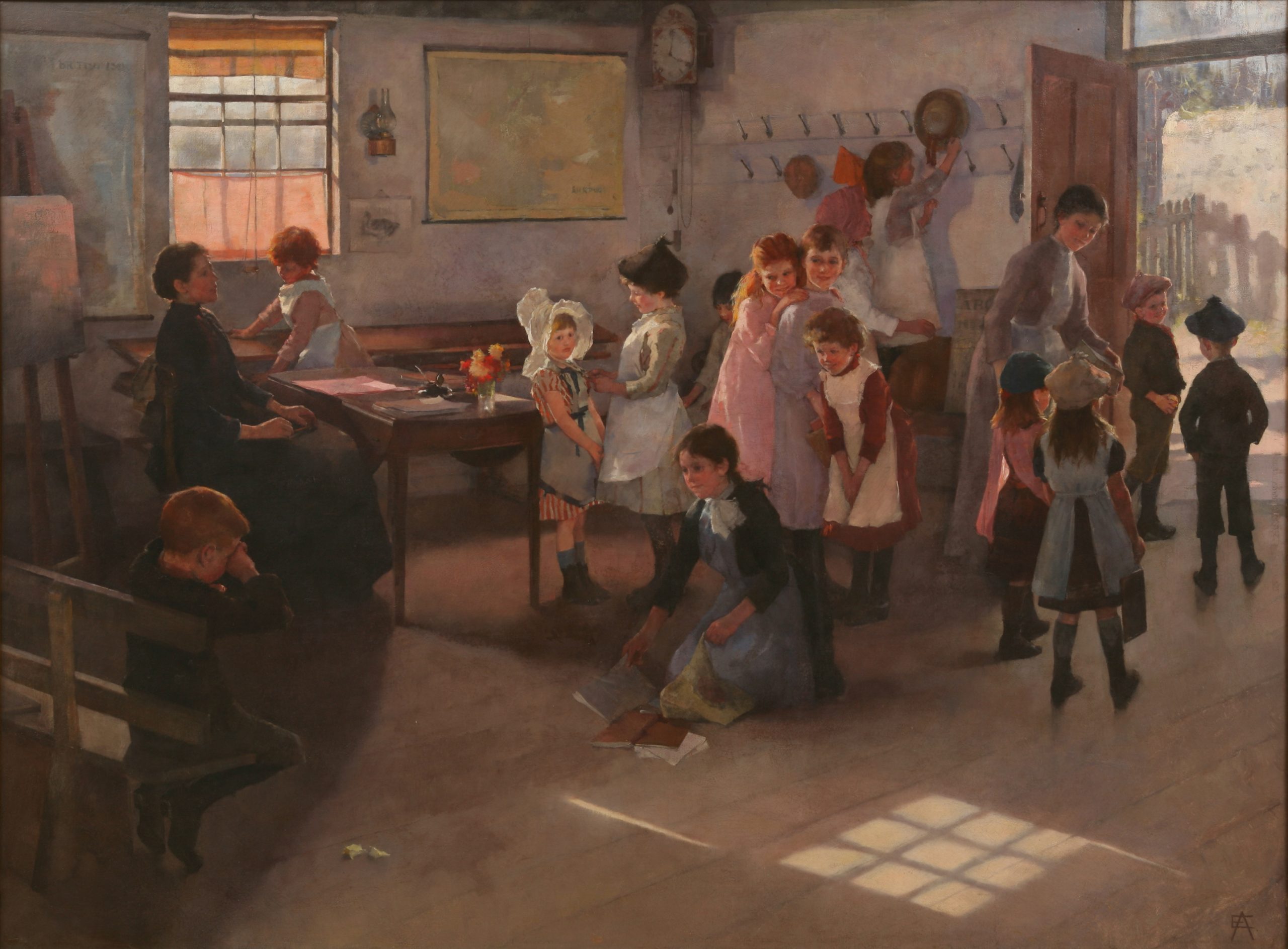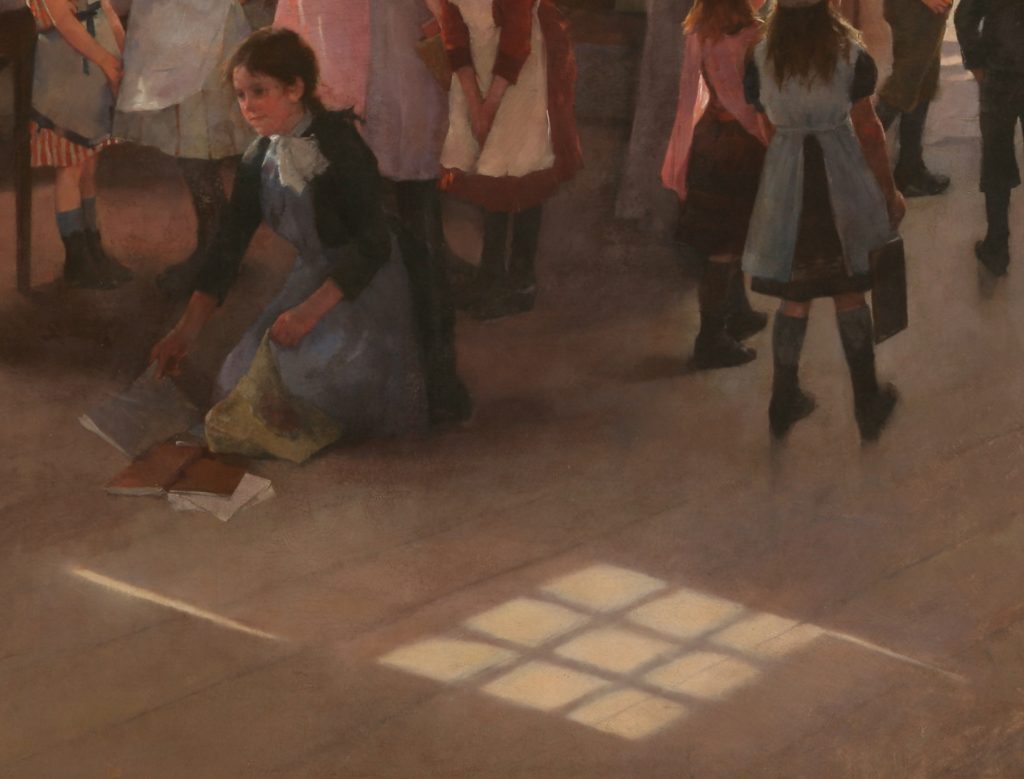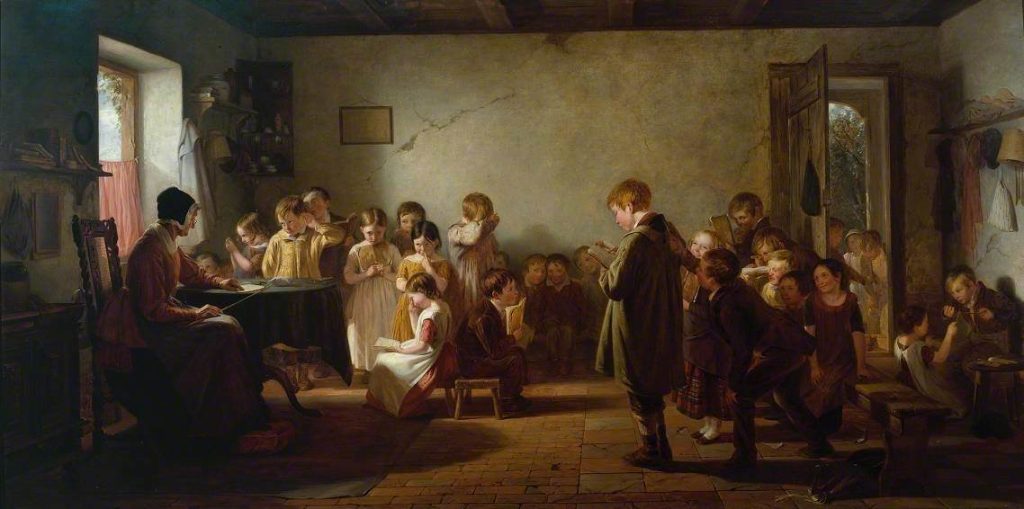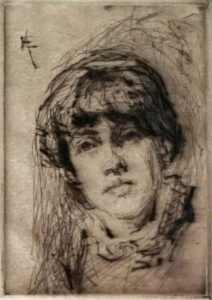School Is Out (1889)
by Dr. Amy Wallace

A highly anticipated yet ordinary moment in the daily lives of a group of rural children is captured by Elizabeth Forbes in School is Out: the routine of class dismissal. This end-of-day ritual generates a variety of reactions from the students in the painting. A red-headed boy in the foreground raises his hands to his face in a display of emotion, while a girl in a blue pinafore gathers the books that he has presumably thrown on the floor. A teacher seated stiffly at a desk topped with neatly arranged stacks of paper—a small display of orderliness in the classroom—disregards the interaction, leaving viewers to ponder its cause and eventual resolution. Although the end of the school day has finally arrived, other students in the classroom look distracted. A young girl by the window is lost in reverie, and a student at the back of the classroom sits alone, displaying a forlorn expression. While the subject matter of School is Out appears straightforward, the painting addresses a much less tangible yet ever-present dimension of daily life: the passage of time.
Natural time vs. clock time
In his 1887 novel The Woodlanders, the English writer Thomas Hardy contrasted the natural apprehension of time with the precise time-keeping of a clock: “The countryman who is obliged to judge the time of day from changes in external nature sees a thousand successive tints and traits in the landscape which are never discerned by him who hears the regular chime of a clock.”[1] The implication is that clocks, and the industrial labour they regulated, alienated individuals from nature—a nineteenth-century anxiety related to urbanization. Like the countryman in Hardy’s The Woodlanders, however, Naturalist painters like Forbes were attuned to the changing “tints and traits in the landscape” which signalled the passage of time. Naturalists inherited a focus on carefully observing external nature from movements such as Realism and Pre-Raphaelitism earlier in the century. In School is Out, Forbes has included instances of these natural time signals to juxtapose two methods of time-keeping: natural time and clock time.
While clocks were used to regulate time before the industrial revolution, the accelerating pace of industrial capitalism in England marked the beginning of a new temporal awareness in the nineteenth century. The standardization of time was partially necessitated by the expansion of railroads. In addition to coordinating train schedules, the precise time-keeping of clocks synchronized work and determined the boundaries between labour and leisure. A clock in the back corner of School is Out displays a time shortly after 4:00 p.m., reminding viewers that even the lives of rural school children were subject to the regulating force of clock time. The exposed pendulum and weights make visible the mechanical nature of clock time, which is contrasted with signifiers of natural time throughout the painting.

Forbes registers the progression of natural time through the manipulation of light and shadow. Viewers’ eyes are drawn to a grid of sunlight on the schoolroom’s wooden floor; its angle in relation to the window implies a low light characteristic of the late afternoon. Viewers can imagine the light’s trajectory across the floor during the day, visibly marking the passage of time through its movement, similar to the rotating hands of a clock. Likewise, the light’s noticeably warm hue suggests that the sun has moved closer to the horizon during the late afternoon. Another signal of natural time is visible through the open door that provides a view of the world outside, where long shadows cast by a fence replicate the effect of late afternoon sunlight. Like the teachers who attempt to bring a sense of order to the classroom, the regularity of clock time is superimposed upon these natural time signals in the painting. Forbes foregrounds the progression of natural time as an enduring force operating alongside mechanized clock time.

The significance of Forbes’s treatment of light and its connection to time becomes evident through a comparison to Thomas Webster’s A Dame’s School (1845) from earlier in the century. Webster was a British artist whose popular genre scenes were widely reproduced as prints. Both Webster’s and Forbes’s paintings depict the interior of a rural schoolhouse and are framed by a window and a door. Given their similarities, it is possible that Forbes was familiar with A Dame’s School or printed reproductions of the painting. In Webster’s painting, the window functions as a traditional light source, illuminating the figures and space from the left side of the composition. By adjusting the position of the viewer, Forbes makes the window and the light that passes through it complementary focal points of the composition. Beyond serving only as a means of illumination, the ephemerality of light and its relationship to time become subjects in and of themselves. Crucially, no clocks are displayed in Webster’s classroom; his rural schoolhouse is quite literally timeless. The inclusion of a clock in Forbes’s later painting suggests how the experience of time in England had transformed in the forty-some years between the creation of both paintings.
A Canadian woman artist abroad
In addition to juxtaposing the coexisting temporalities of natural time and clock time in late nineteenth-century England, School is Out alludes to the internationalization of art during this period. Displayed on either side of the central window, two maps representing the British Isles and Europe are reminders that Forbes was an expatriate Canadian artist in England when she painted School is Out. Born in Ontario in 1859, Forbes later moved to London, where she studied at the South Kensington Art Schools. During this early period of study, she lived beside the Pre-Raphaelite artist Dante Gabriel Rossetti, whose art influenced Forbes’s preference for poetic and historicizing subjects in later works such as Will-O’-the-Wisp (c. 1900). In addition to training in London, Forbes studied at the Art Students League of New York with the American artist William Merritt Chase. She later spent time at a number of artists’ colonies, including Pont-Aven in Brittany, Zandvoort in Holland, and St. Ives in Cornwall. Forbes eventually settled in Newlyn, where a colony of artists collectively known as the Newlyn School formed. A schoolhouse in the nearby village of Paul likely provided the inspiration for School is Out.

Forbes’s level of mobility was unusual for a woman artist in the nineteenth century, and she encountered barriers in the pursuit of her artistic training. Reflecting on a period of study in Munich, Forbes stated, “In the recognised art training of the schools, I found my sex to be a perpetual disadvantage.”[2] Women artists in the nineteenth century faced systemic discrimination from the male-dominated art academies. They also had limited access to drawing from nude models, a foundational element of artistic training. For example, the Royal Academy of Arts in London did not admit female students until 1861 and did not offer a life drawing class for women until 1893, four years after School is Out was painted. Despite the obstacles that existed for women artists in the nineteenth century, Forbes’s peripatetic lifestyle nevertheless enabled the Canadian-born artist to participate in national and international artistic movements, including Naturalism, Impressionism, Aestheticism, and late Pre-Raphaelitism. Her paintings are a synthesis of the artist’s original vision and the diverse influences—particularly the work of Jean-Francois Millet, John Ruskin, James Abbott McNeill Whistler, and Jules Bastien-Lepage—that she encountered on her extensive travels. The rustic naturalism of School is Out can especially be traced to Millet’s depictions of rural labourers. Rather than representing the daily toil of the labourers themselves, however, Forbes focuses on the quotidian habits of their children.
Forbes was a central figure at the Newlyn School, establishing the Newlyn School of Painting with her husband, Stanhope Forbes, in 1899. The school became recognized as a forum for international artistic exchange. Describing the enrolment at the school, one writer stated, “The influence of the school is likely to be widespread; for besides the larger proportion of the students from near home, many have come out of far lands—from Australia, from China and Chili; from the southern and the northernmost parts of Europe; from India and Canada and New Zealand.”[3] School is Out depicts a rural schoolhouse in late nineteenth-century England, while simultaneously gesturing through its inclusion of two maps to the larger networks of international exchange in which Forbes participated. Inside the modest dimensions of a one-room schoolhouse, Forbes manages to contain the enormity of both time and space.
About the author
Dr. Amy Wallace is an art historian whose research focuses on intersections of art and the environment in the nineteenth and early twentieth centuries. She holds a PhD from the University of Toronto and has taught art history at Carleton University, the University of Ottawa, and the University of Toronto.
Further reading
Birch, Mrs. Lionel. Stanhope A. Forbes, A.R.A., and Elizabeth Stanhope Forbes, A.R.W.S. London: Cassell and Company Limited, 1906.
Burton, Samantha. “A Canadian Artist in King Arthur’s Court: Elizabeth Armstrong Forbes and the Colonial Invention of British Tradition.” Journal of Canadian Art History 34, no. 2 (2013): 142–77.
Canadian Women Artists History Initiative. “Forbes, Elizabeth Armstrong.” Last modified September 12, 2023.
Cook, Judith, Melissa Hardie, and Christiana Payne. Singing from the Walls: The Life and Art of Elizabeth Forbes. Bristol: Sansom & Company in association with Penlee House Gallery & Museum, 2000.
Crozier, Gladys B. “Elizabeth Stanhope Forbes.” The Art Journal 66 (1904): 382–84.
Dombrowski, André. “Impressionism and the Standardization of Time: Claude Monet at Gare Saint-Lazare.” The Art Bulletin 102, no. 2 (2020): 91–120.
Fox, Caroline. “Elizabeth Forbes.” In Stanhope Forbes and the Newlyn School, 43–51. Newton Abbot: David & Charles, 1993.
Hardy, Thomas. The Woodlanders. 3 vols. London and New York: Macmillan, 1887.
Thompson, E. P. “Time, Work-Discipline, and Industrial Capitalism.” Past & Present, no. 38 (1967): 56–97.
Young, Marnin. “The Motionless Look of a Painting: Jules Bastien-Lepage, Les Foins, and the End of Realism.” Art History 37, no. 1 (2014): 38–67.
The transition from an agricultural to industrial economy that began in Britain in the late eighteenth century and resulted in widespread social and technological changes.
A progressive art school established in 1875 in New York that trained many of the leading American artists of the 19th and 20th centuries.
An English artists' colony that formed in the early 1880s in Newlyn, Cornwall, and was influential in the development of pleinairism in Britain.

